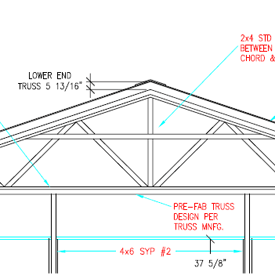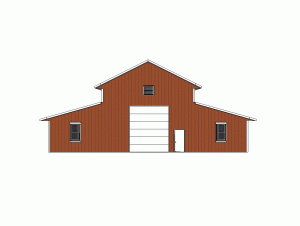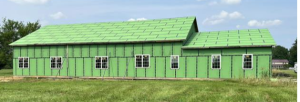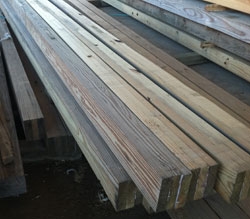When NOT to Measure 5-1/2 Inches for a 2×6
My lovely bride is an RN (Registered Nurse) by training and profession. In medicine 100mg is 100mg, not 87.5mg and someone’s heart rate might be 80, not “somewhere between 80 and 120”. Wrapping her head around why a 2×6 is 1-1/2 inches by 5-1/2 inches just didn’t make any sense to her when she first entered the building industry over a dozen years ago.
Can’t blame her.
There also comes a time in construction, when measuring for the amount of space taken up by a 2×6, just isn’t 5-1/2 inches measured vertically.
Before declaring me a nut job, or a few nuggets short of a McDonald’s® Happy Meal® please read on….
In most parts of the country, pole building roof purlins (the roof framing running the length of the building) are placed between the top chords of the roof trusses and supported by joist hangers. This makes the upper surface of all the framing members a nice smooth plane (albeit at the slope of the roof).
When a roof overhang is created beyond the end of a building, the end trusses are lowered so the purlins can cross over the top of the end truss. This cantilever creates a very strong and study overhang.
So, the end truss gets lowered by 5-1/2 inches to make up for the 2×6 purlins, right?
Only if you are willing to have the roof be higher at the ends of the building, than in the interior. Most folks do not especially like this look.
Okay, so how far IS the end truss lowered?
The end truss needs to be lowered by the height of the purlin adjusted for the slope of the roof.
Taking a leap back to middle school or high school mathematics….Square both numbers of the slope, add them together, take the square root of the sum, divide by 12 (converting feet to inches) and multiply by the height of the 2×6 (5-1/2 inches). The steps of the equation look something like this (for a 4/12 roof slope):
4^2 = 16
12^2 = 144
16 + 144 = 160
SQR of 160 = 12.649
12.649 / 12 = 1.0541
1.0541 X 5.5 = 5.798 inches or 5-13/16”
On a 4/12 roof slope, with 2×6 purlins overhanging the end truss to support the end overhang, the end trusses must be set lower on the columns than the interior trusses by 5-13/16 inches.
 The plans provided by Hansen Pole Buildings for our clients to construct their buildings with, do give this dimension on the plans. Also, it is provided in our Construction Manual in a table which gives the lowering distance for every whole numbered roof slope from 2/12 to 8/12 and purlins sizes from 2×6 to 2×10.
The plans provided by Hansen Pole Buildings for our clients to construct their buildings with, do give this dimension on the plans. Also, it is provided in our Construction Manual in a table which gives the lowering distance for every whole numbered roof slope from 2/12 to 8/12 and purlins sizes from 2×6 to 2×10.
Even with all of this information, there are clients who just can’t wrap their heads around it. They really want to insist they lower the end truss 5-1/2”, not the 5-13/16” which is required to make their roof a true plane.
For them, I recommend taking a leap of faith. This isn’t our first rodeo. We actually have tried this out a few thousand times – and remarkably, it has worked every single time.
Try it out yourself, and send me an email if you happen to be the first person where it doesn’t work!










Thanks for the detailed explanation. I find it funny that some of your clients can’t wrap their heads around that, while it’s mathematically computed from a middle school book. I think they’re forgetting that the drop in truss height is vertical, whereas the orientation of the purlin is angled. The orthogonal gap that the purlin fills between the two trusses at that angle is less than distance travelled vertically by the lowered truss